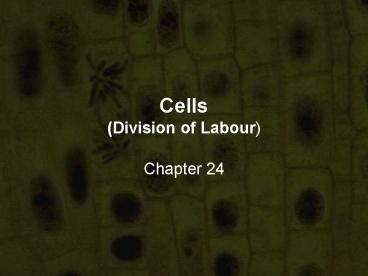Cells (Division of Labour) - PowerPoint PPT Presentation
1 / 38
Title:
Cells (Division of Labour)
Description:
Cells (Division of Labour) Chapter 24 Plant Transport System From Systems to Organisms Organism Made up of different systems working effectively in a coordinated ... – PowerPoint PPT presentation
Number of Views:312
Avg rating:3.0/5.0
Title: Cells (Division of Labour)
1
Cells(Division of Labour)
- Chapter 24
2
In this chapter, you will learn
- that cells of similar structures are organised
into tissues - that several tissues may make up an organ
- that organs are organised into systems
- to explain the significance of division of labour
3
Unicellular Organisms
Paramecium
Amoeba
4
Unicellular Organisms
- Paramecium
- Microscopic organism
- Found on surface of water (eg pond, river)
- Has hair surrounding the body for movement
- Has a mouth
5
Unicellular Organisms
- Amoeba
- Often found at bottom of ponds or under rocks
- Does not move fast
- No arms, legs, eyes, mouth
- Eats by surrounding its prey with its body
- Lives only for 2 days
- Reproduce by spliting itself into 2 new amoebas
6
Multicellular Organisms
- Have many different cells
- Different cells perform different functions
- Examples
- Plants
- Humans
7
Cells in a Human
- Examples
- Red blood cell (transport oxygen)
- Nerve cell (have nerve fibres to transmit signals
to and from the central nervous system)
8
Cells in a Plant
- Examples
- Root hair cell
- Leaf guard cell
9
From cells to tissues
- Tissue
- Group of similar cells that are specialised to
perform a particular function
10
Tissues in a Human
- Epithelial tissue
- Covering or lining tissue to protect structure
beneath it - Connective tissue
- Joins, stores or supports all parts of an organism
11
Tissues in a Human
- Muscle tissue
- Cause movement
- Nerve tissue
- Carry messages from one part of body to another
by conducting electrical signals
12
Tissues in a Plant
- Epidermal tissue
- Protects plant against injury and losing too much
water - Vascular tissue
- Transports materials within a plant
13
Tissues in a Plant
- Photosynthesis tissue
- Carries out photosynthesis in a plant
14
From Tissues to Organs
- Organ
- Group of specialised tissues that are gathered in
a certain part of the body to perform a
particular function together
15
Organs in a Human
- Examples
- Skin
- Lungs
- Heart
16
Organs in a Plant
- Examples
- Leaves
- Stem
- Roots
- Flowers
17
From Organs to Systems
- System
- Different organs working together to perform a
major function in an organism
18
Main Organ Systems in a Human
- Respiratory system
- Digestive system
- Blood circulatory system
- Skeletal system
- Muscular system
19
Respiratory System
20
Respiratory System
- Respiration
- Process in which cells release energy from the
food we eat - Oxygen is required
- Carbon dioxide is removed
21
Respiratory System
- Mechanics of breathing
22
Digestive System
23
Digestive System
- Digestion
- Process in which large, insoluble food substances
are broken down into smaller, soluble food
substances for absorption into blood
24
Blood Circulatory System
25
Blood Circulatory System
- Transports nutrients, gases, water and hormones
to different parts of the body - Include red blood cells, white blood cells,
heart, blood vessels
Red blood cells
White blood cells
26
Skeletal System
27
Skeletal System
- Supports our body
- Gives us shape
- Protects our organs
- Enables movement
28
Muscular System
29
Muscular System
- Enables movement by contraction and relaxation of
muscles - 3 muscle types
- Skeletal muscles
- Smooth muscles
- Cardiac muscles
30
Other systems in Human
- Reproductive System
- - Produces sex cells (sperm, ovum)
- For reproduction
- Nervous System
- - Consists of the brain, spinal cord and nerves
found throughout our body - - Controls and coordinates functions throughout
our body - - Enables us to respond to changes around us
31
Male Reproductive System
32
Female Reproductive System
33
Nervous System
34
Plant Transport System
35
From Systems to Organisms
- Organism
- Made up of different systems working effectively
in a coordinated manner
36
The Human Body - An organism
37
Division of Labour
- Each cell in a multicellular organism does not
perform all the bodily functions. - Each type of cell specialises in performing one
particular function. - Different functions in a multicellular organism
can be performed at the same time by division of
labour.
38
Division of Labour
- Division of labour
- Sharing different functions in an organism among
its cells, tissues, organs and systems - Ensures smooth running and effective working of
the different parts in an organisms as well as
the organism as a whole































